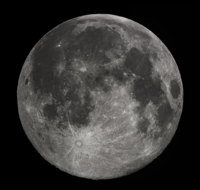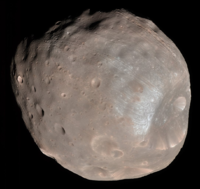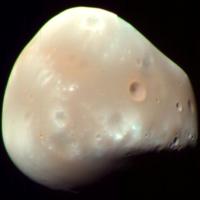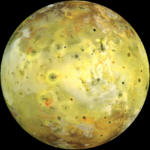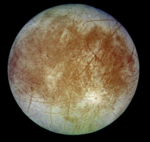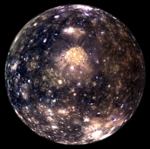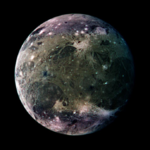Difference between revisions of "Moon"
| (4 intermediate revisions by 2 users not shown) | |||
| Line 28: | Line 28: | ||
|+ The four largest moons of [[Jupiter]]. | |+ The four largest moons of [[Jupiter]]. | ||
|- | |- | ||
| − | | style="height:20px; width: | + | | style="height:20px; width:150px; text-align:center;" |Io |
| − | | style="height:20px; width: | + | | style="height:20px; width:150px; text-align:center;" |Europa |
| − | | style="height:20px; width: | + | | style="height:20px; width:150px; text-align:center;" |Callisto |
| − | | style="height:20px; width: | + | | style="height:20px; width:150px; text-align:center;" |Ganymede |
|- | |- | ||
| − | |[[File:Io.png|center| | + | |[[File:Io.png|center|150px]] |
| − | |[[File:Europa.png|center| | + | |[[File:Europa.png|center|150px]] |
| − | |[[File:Callisto.png|center| | + | |[[File:Callisto.png|center|150px]] |
| − | |[[File:Ganymede.png|center| | + | |[[File:Ganymede.png|center|150px]] |
|} | |} | ||
| Line 47: | Line 47: | ||
: Most [[moon]]s are too small to have enough [[gravity]] to become round. They can be [[asteroid]]s that were captured into [[orbit]] by a [[planet]]s [[gravity]]. | : Most [[moon]]s are too small to have enough [[gravity]] to become round. They can be [[asteroid]]s that were captured into [[orbit]] by a [[planet]]s [[gravity]]. | ||
: [[Mercury]] and [[Venus]] do not have any [[moon]]s. All other [[planet]]s have one or more [[moon]]s. | : [[Mercury]] and [[Venus]] do not have any [[moon]]s. All other [[planet]]s have one or more [[moon]]s. | ||
| + | |||
| + | {| class="wikitable" | ||
| + | |+ The Moon orbiting [[Earth]]. | ||
| + | |[[File:TheMoon.png|center|200px]] | ||
| + | |} | ||
| + | |||
| + | {| class="wikitable" | ||
| + | |+ The two moons orbiting [[Mars]]. | ||
| + | |- | ||
| + | | style="height:20px; width:200px; text-align:center;" |Phobos | ||
| + | | style="height:20px; width:200px; text-align:center;" |Deimos | ||
| + | |- | ||
| + | |[[File:Phobos.png|center|200px]] | ||
| + | |[[File:Deimos.png|center|200px]] | ||
| + | |} | ||
| + | |||
| + | {| class="wikitable" | ||
| + | |+ The four largest moons of [[Jupiter]]. | ||
| + | |- | ||
| + | | style="height:20px; width:150px; text-align:center;" |Io | ||
| + | | style="height:20px; width:150px; text-align:center;" |Europa | ||
| + | | style="height:20px; width:150px; text-align:center;" |Callisto | ||
| + | | style="height:20px; width:150px; text-align:center;" |Ganymede | ||
| + | |- | ||
| + | |[[File:Io.png|center|150px]] | ||
| + | |[[File:Europa.png|center|150px]] | ||
| + | |[[File:Callisto.png|center|150px]] | ||
| + | |[[File:Ganymede.png|center|150px]] | ||
| + | |} | ||
| + | |||
| + | ==Key Stage 4== | ||
| + | ===Meaning=== | ||
| + | A [[moon]] is a large [[rock]] which [[Orbit|orbits]] a [[planet]]. | ||
| + | |||
| + | ===About Moons=== | ||
| + | : [[Moon]]s are natural [[satellite]]s [[orbit]]ing a [[planet]]. | ||
| + | : Most [[moon]]s are too small to have enough [[gravity]] to become round. They can be [[asteroid]]s that were captured into [[orbit]] by a [[planet]]s [[gravity]]. | ||
| + | : [[Mercury]] and [[Venus]] do not have any [[moon]]s. All other [[planet]]s have one or more [[moon]]s. | ||
| + | |||
| + | {| class="wikitable" | ||
| + | |+ The Moon orbiting [[Earth]]. | ||
| + | |[[File:TheMoon.png|center|200px]] | ||
| + | |} | ||
| + | |||
| + | {| class="wikitable" | ||
| + | |+ The two moons orbiting [[Mars]]. | ||
| + | |- | ||
| + | | style="height:20px; width:200px; text-align:center;" |Phobos | ||
| + | | style="height:20px; width:200px; text-align:center;" |Deimos | ||
| + | |- | ||
| + | |[[File:Phobos.png|center|200px]] | ||
| + | |[[File:Deimos.png|center|200px]] | ||
| + | |} | ||
| + | |||
| + | {| class="wikitable" | ||
| + | |+ The four largest moons of [[Jupiter]]. | ||
| + | |- | ||
| + | | style="height:20px; width:150px; text-align:center;" |Io | ||
| + | | style="height:20px; width:150px; text-align:center;" |Europa | ||
| + | | style="height:20px; width:150px; text-align:center;" |Callisto | ||
| + | | style="height:20px; width:150px; text-align:center;" |Ganymede | ||
| + | |- | ||
| + | |[[File:Io.png|center|150px]] | ||
| + | |[[File:Europa.png|center|150px]] | ||
| + | |[[File:Callisto.png|center|150px]] | ||
| + | |[[File:Ganymede.png|center|150px]] | ||
| + | |} | ||
| + | |||
| + | ===References=== | ||
| + | ====AQA==== | ||
| + | |||
| + | :[https://www.amazon.co.uk/gp/product/1471851370/ref=as_li_tl?ie=UTF8&camp=1634&creative=6738&creativeASIN=1471851370&linkCode=as2&tag=nrjc-21&linkId=01c69b0ae058f809cf636033e6ba793e ''Moon, orbit of, page 250, GCSE Physics, Hodder, AQA ''] | ||
| + | :[https://www.amazon.co.uk/gp/product/019835939X/ref=as_li_tl?ie=UTF8&camp=1634&creative=6738&creativeASIN=019835939X&linkCode=as2&tag=nrjc-21&linkId=57e96876985fc39b1a3d8a3e3dc238b6 ''Moon, page 11, GCSE Physics; Third Edition, Oxford University Press, AQA ''] | ||
| + | :[https://www.amazon.co.uk/gp/product/0008158770/ref=as_li_tl?ie=UTF8&camp=1634&creative=6738&creativeASIN=0008158770&linkCode=as2&tag=nrjc-21&linkId=ec31595e720e1529e49876c3866fff6e ''Moon, pages 278-9, 290, 292, GCSE Physics; Student Book, Collins, AQA ''] | ||
| + | :[https://www.amazon.co.uk/gp/product/178294558X/ref=as_li_tl?ie=UTF8&camp=1634&creative=6738&creativeASIN=178294558X&linkCode=as2&tag=nrjc-21&linkId=f0dfb66dafcb0c6e9449e7b1a4ae1ac319 ''Moons, page 101, GCSE Physics; The Revision Guide, CGP, AQA ''] | ||
| + | :[https://www.amazon.co.uk/gp/product/1471851370/ref=as_li_tl?ie=UTF8&camp=1634&creative=6738&creativeASIN=1471851370&linkCode=as2&tag=nrjc-21&linkId=01c69b0ae058f809cf636033e6ba793e ''Moons, page 249, GCSE Physics, Hodder, AQA ''] | ||
| + | :[https://www.amazon.co.uk/gp/product/1782945970/ref=as_li_tl?ie=UTF8&camp=1634&creative=6738&creativeASIN=1782945970&linkCode=as2&tag=nrjc-21&linkId=a120d24dcc7cc7a58192069a3aafc1d2 ''Moons, page 320, GCSE Physics; The Complete 9-1 Course for AQA, CGP, AQA ''] | ||
| + | :[https://www.amazon.co.uk/gp/product/0008158770/ref=as_li_tl?ie=UTF8&camp=1634&creative=6738&creativeASIN=0008158770&linkCode=as2&tag=nrjc-21&linkId=ec31595e720e1529e49876c3866fff6e ''Moons, pages 275, 277, GCSE Physics; Student Book, Collins, AQA ''] | ||
| + | |||
| + | ====OCR==== | ||
| + | :[https://www.amazon.co.uk/gp/product/0198359837/ref=as_li_tl?ie=UTF8&camp=1634&creative=6738&creativeASIN=0198359837&linkCode=as2&tag=nrjc-21&linkId=3c4229e8b023b2b60768e7ea2307cc6f ''Moons, pages 238, Gateway GCSE Physics, Oxford, OCR ''] | ||
Latest revision as of 06:31, 15 December 2019
Contents
Key Stage 2
Meaning
A moon is a large rock which orbits a planet.
About Moons
- If it goes around a planet and it was not made by humans then it is called a moon.
- The Earth has one moon called The Moon.
- Some planets have no moons like Mercury and Venus.
- Some planets have many moons. Jupiter has 67 moons.
Examples
| Phobos | Deimos |
| Io | Europa | Callisto | Ganymede |
Key Stage 3
Meaning
A moon is a large rock which orbits a planet.
About Moons
- Moons are natural satellites orbiting a planet.
- Most moons are too small to have enough gravity to become round. They can be asteroids that were captured into orbit by a planets gravity.
- Mercury and Venus do not have any moons. All other planets have one or more moons.
| Phobos | Deimos |
| Io | Europa | Callisto | Ganymede |
Key Stage 4
Meaning
A moon is a large rock which orbits a planet.
About Moons
- Moons are natural satellites orbiting a planet.
- Most moons are too small to have enough gravity to become round. They can be asteroids that were captured into orbit by a planets gravity.
- Mercury and Venus do not have any moons. All other planets have one or more moons.
| Phobos | Deimos |
| Io | Europa | Callisto | Ganymede |
References
AQA
- Moon, orbit of, page 250, GCSE Physics, Hodder, AQA
- Moon, page 11, GCSE Physics; Third Edition, Oxford University Press, AQA
- Moon, pages 278-9, 290, 292, GCSE Physics; Student Book, Collins, AQA
- Moons, page 101, GCSE Physics; The Revision Guide, CGP, AQA
- Moons, page 249, GCSE Physics, Hodder, AQA
- Moons, page 320, GCSE Physics; The Complete 9-1 Course for AQA, CGP, AQA
- Moons, pages 275, 277, GCSE Physics; Student Book, Collins, AQA
